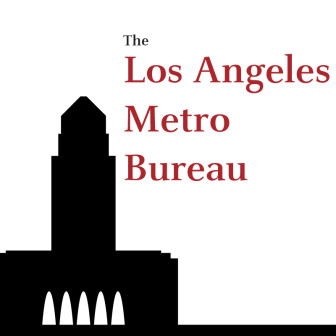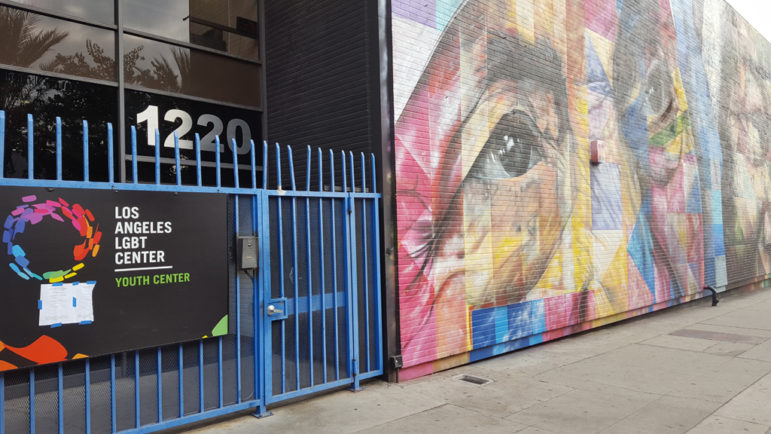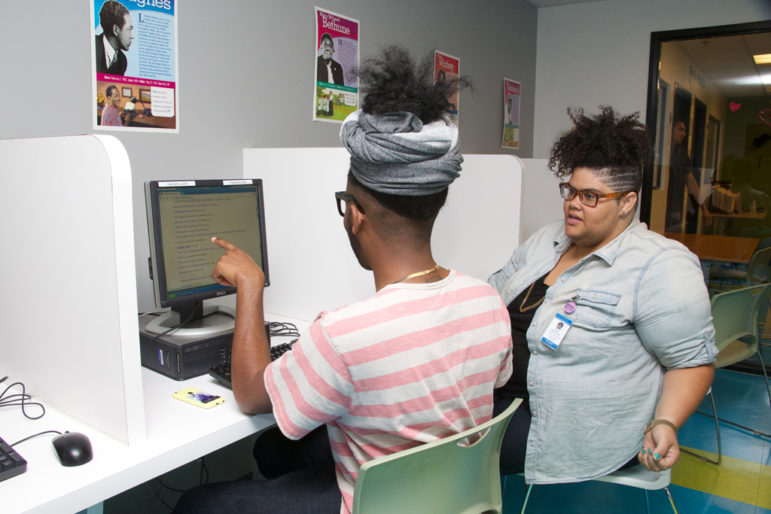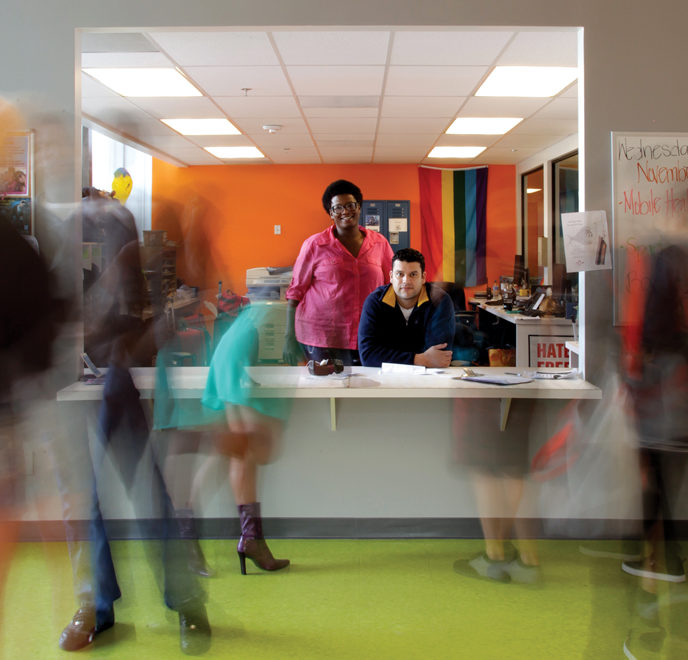LOS ANGELES — Growing up on the tough South Side of Chicago, Richard never felt comfortable around people because he never felt normal as a gay youth in a heterosexual world. He never told his parents about his sexual orientation, still hasn’t. He felt threatened by other kids who liked to bully and beat up gay students.
So, after graduating from high school he got on a plane and left for Los Angeles, where he thought he could be open and accepted for who he is.
Today, he is a student at Los Angeles City College studying to become a nurse.
 “I can be myself here,” said Richard, 22. “It’s cool to be around so many LGBTQ people. It’s almost like normal.”
“I can be myself here,” said Richard, 22. “It’s cool to be around so many LGBTQ people. It’s almost like normal.”
Richard, who asked that his last name not be used mostly because his parents still don’t know he is gay, is now comfortable with his life largely because of the Los Angeles LGBT Center in Hollywood.
The center, which was founded in 1969 and now has nearly 600 employees, proudly claims it has provided services for more LGBT people than any other organization in the world.
Free services with LGBT focus
Its services and programs, which are free or low-cost, cover four broad categories in six locations in the Los Angeles area: health (including primary health services and HIV testing and services), social services and housing, culture and education — including a charter school, computer center and scholarships for LGBT college-bound students — leadership and advocacy, including a OUT™ for Safe Schools program.
The center’s fact sheet claims it has more than 42,000 visits monthly from youth and adults. It is one of the few Federally Qualified Health centers (a reimbursement designation) in the country with providers who specialize in primary care for LGBT people.
The Youth Center sees 70 to 100 people per day, many repeat visitors, and about 1,100 unique visitors each year, according to Mandy Litwin, the center’s Youth Education Center supervisor.
Its medical services include specialty practices, including a transgender health program and the Audre Lorde Lesbian Health Program, and its mental health programs offer individual and group counseling and psychiatric care by providers who specialize in serving LGBT people.
The center also has a program to reduce the number of LGBT youth in long-term foster care and help them find permanent homes. They do that by working with the youth, parents, caregivers and child welfare professionals to combat the heterosexism and transphobia that frequently results in the mistreatment and abuse of LGBT youth, who are estimated to be one in five of all foster youth. According to the center, LGBT foster youth are two times as likely to live in a group facility, and are twice as likely to report poor treatment by the foster care system.

Photo by Julio Moran
.
Different needs for gender-minority kids
Jeremy T. Goldbach, an assistant professor at the University of Southern California’s Suzanne Dworak-Peck School of Social Work who specializes on LGBT youth issues, said facilities such as the LA LGBT center are needed nationwide.
“This is a place where when you come in you don’t have to worry about being stigmatized,” Goldbach said. “There are different needs for gender-minority kids than other kids.”
“LGBTQ youth have unique needs that are sometimes not addressed in mainstream environments — questions about dating, sex, relationships, finding role models, etc. These things can be different [for LGBT youth],” he said.
For youths — which the center defines as 18 to 24 years old — the center focuses on nationwide homelessness and education. It offers a charter school for LGBT youths who want a high school diploma but don’t feel comfortable or safe in traditional schools. It also offers a GED program, boasting a 100 percent success rate. Once students complete either program, the center offers help for those who want to pursue a college education or find a job.
Ashley, 19, from El Centro, California, said she moved to Los Angles simply to “get away” from home. She said she didn’t like school because she didn’t get any support from her family or school officials. Rather than opt for a GED, she decided to enroll in the charter school to get a diploma.
“Here, I get that support from the staff and I learn more,” she said. “I felt it would be better to have a diploma rather than a GED to get into college.” She expects to graduate this year.
Ashley is now succeeding in school because there is more support with her lessons: “I am learning more because I have better help.”
Litwin, the center’s youth education supervisor, says when young people first arrive at the center, they receive counseling and support for physical or mental health issues, which often come from living in the streets.
“Many of the health issues come from being cold, hungry and scared,” Litwin said.
Complexities from homelessness
There were 2,388 homeless youth in Los Angeles County in 2016, according to the
Los Angeles Homeless Services Authority, which conducts an annual count in the county — minus the cities of Long Beach, Glendale and Pasadena.
However, the center’s published material says, “On any given day there are more than 6,100 homeless youth (ages 24 and younger) living on the streets of Los Angeles.” That’s because unlike the authority, the center counts people who temporarily stay with friends.
“Most of the time the youths are just looking for a meal or just to use a bathroom,” said Litwin, noting that many of the youths coming to the center lack basic needs.
The youth center on Highland offers 14 rooms for homeless youth for one to 30 nights. It also offers three meals per day, showers and clothing, and free haircuts once per month.
To help deal with homelessness, the center also offers a 24-bed Transitional Living Program (TLP) where youth can stay for up to 18 months, and affordable apartments for youth who graduate from the TLP. More than 90 percent of youth leaving the TLP have secured stable housing and employment and/or scholarships for college that enable them to live independently, according to the center.
Kat, who came to Los Angeles from Georgia three years ago when she was 21, first lived on Skid Row before living at the youth center for 30 days. Since then, she has completed her GED and is now attending Los Angeles City College with the hope of becoming an actress.
“I never thought I would have the motivation to get this far,” said Kat, who only owned one outfit and one pair of shoes when she arrived. “I feel safe here.”

One of the Youth Center’s education specialists assists a student with his class schedule and course programs in a computer lab also used for youth employment and educational programming.
Educational supports
The center helps those interested in continuing their education with applications, admissions and financial aid, and offers its own scholarships.
“A lot of people think they can’t afford to go to college, but we show them that with financial aid they can attend for free,” Litwin said.
She added that many of the youths have been told in traditional schools that they are not smart enough to complete their education, and health professionals question their sexual orientation.
“Many come in timid and afraid to make mistakes,” Litwin said. “We try to reassure them that it’s OK to make mistakes, and that they are smart enough to finish their high school diploma or the GED.”
She pointed out one young man who came in to get his GED but was unsure if he was smart enough to pass it. He completed it in a week.
The center also offers computers for recreational use and to create resumes and learn software that can help them land jobs.
Litwin said the center also teaches the youth job interviewing skills, and provides appropriate clothes to wear for job interviews.
“In the communities they come from, many feel they don’t have many options,” Litwin said. “Here, we try to provide them with options. That can be very powerful.”
Julio Moran, a former reporter for the Los Angeles Times, is an adjunct professor of journalism at the USC Annenberg School of Journalism.
Go to OST Hub for more materials & resources on this topic.

























